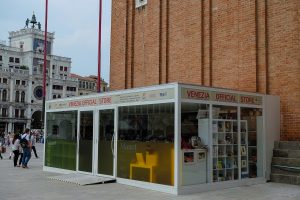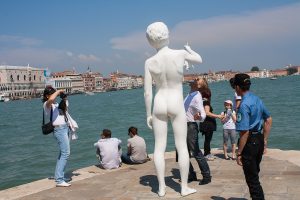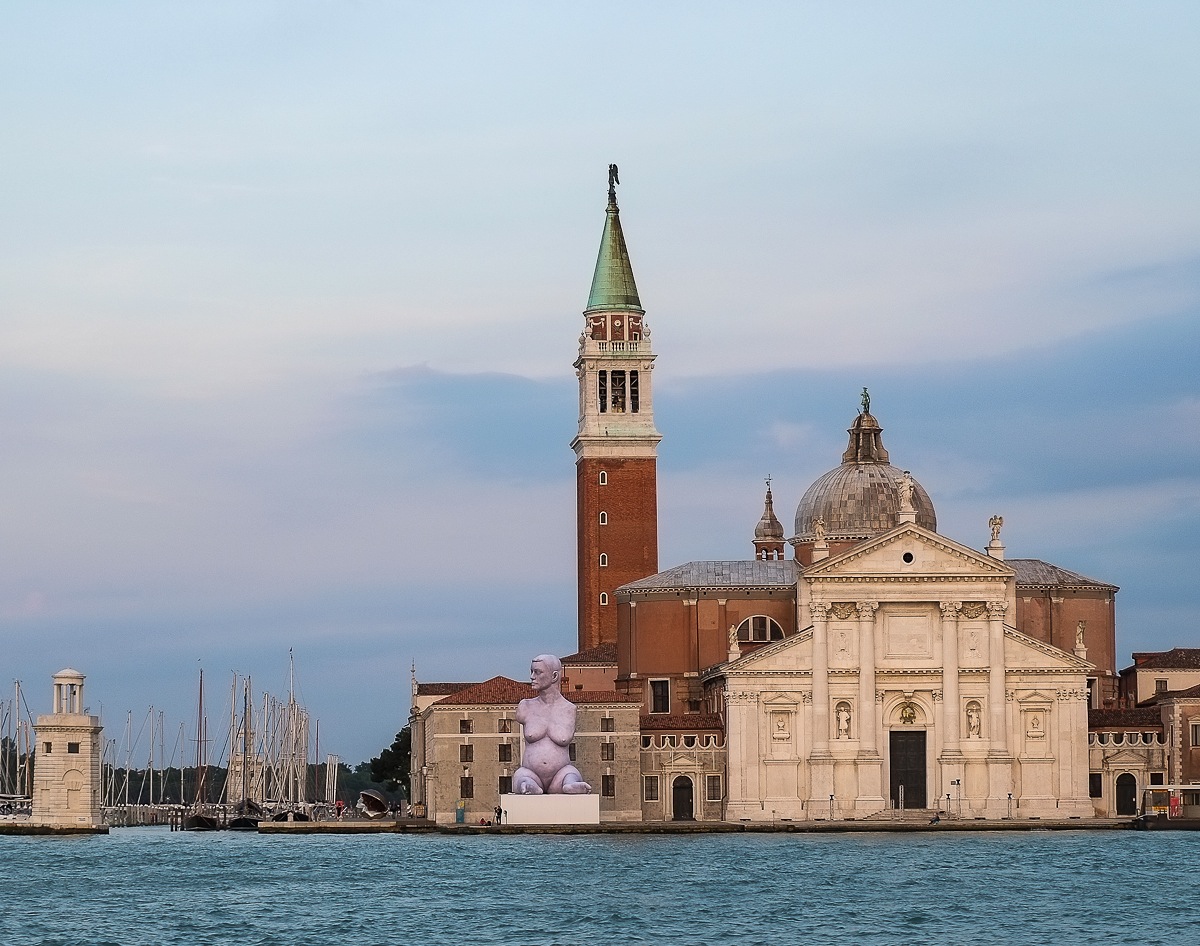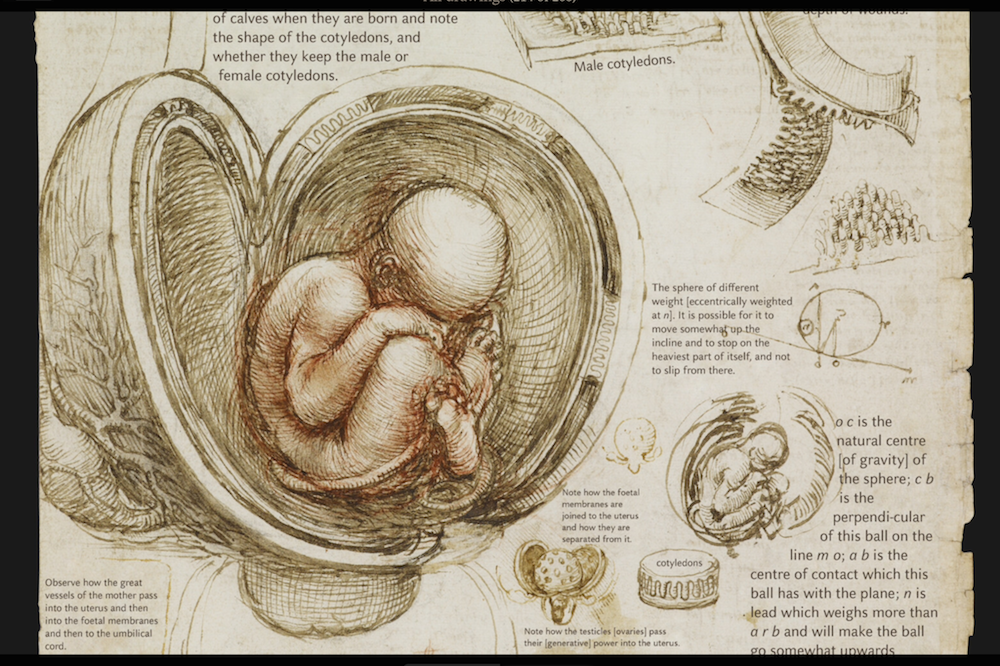Venetians are angry lately, and in a city in which the number of tourists on any given day is greater than the number of residents, their anger is intensified by the suspicion that no one—not even their own elected city officials—is listening. As the number of residents continues to dwindle (it’s now under 60,000 for the first time since the 13th Century), residents have increasingly come to feel that the city in which they grew up is steadily being taken away from them.
Sometimes this anger is manifested in large-scale protests like the one planned for this upcoming weekend against the destructive (and ever-increasing) number of cruise ships bullying past the historical center. At other times it comes out in less-organized but still vocal hostility toward, for example, the 8-foot-tall sculpture called “Boy with a Frog” by American artist Charles Ray on the Punta Della Dogana.
This supposedly “temporary” installation remained there for nearly four years and turned one of the most beautiful public vantage points in Venice into an area occupied during most daylight hours by an armed guard keeping dour watch over the private possession of a French billionaire art collector, François Pinault. Add to this the fact that, though commissioned specifically for this site the sculpture had little to do with it (as there are no frogs in the saltwater of the lagoon and the artist himself admitted it was inspired by Huck Finn), and it’s no surprise that the announcement this past February that the boy would finally be removed was greeted, generally, with local joy. However, the statue wasn’t yet gone in late April when Venetian civic pride suffered a greater blow.
For five years the base of the campanile in Piazza San Marco had been surrounded by a large high-walled (re)construction site. Cracks had been detected in the campanile’s foundation, and, in order to avoid a repeat of its collapse in July 1902, it was reinforced with a girdle of titanium. The work was finally completed just before the important feast of the city’s patron, Saint Mark, on April 25.
Locals had only a few days to appreciate the return of this centrally-important site to them, however, before a “Venezia Official Store” was put up along its western base. Venetians immediately began to refer to it, derisively, as “il gabbiotto” (the crate). A Facebook group was set up demanding its removal (it currently has 6,500 subscribers) and a petition drive undertaken (with 13,500 signatures to date). City officials who’d grandstanded about “the sanctity of the Piazza” last November when a few tourists slipped into bathing suits and treated the flooded quadrangle as their own private swimming pool, now expressed surprise that anyone could be upset by this innocent bit of “marketing” (as they call it in Italian). It’s only temporary, they claimed once again, while a Manet show is running nearby in the Palazzo Ducale. Locals remained unassuaged, and I can’t say I’m surprised.

Though I’ve lived here less than three years, I can attest to how miraculous seems your first sight of one of the city’s landmarks, such as the Bridge of Sighs or Sansovino’s great library, after all the scaffolding and advertising billboards that have obscured it for years are finally removed. So imagine what it must feel like to a Venetian who’s literally grown up with these sites in this intimate little city! To set up a store at the base of the long-obscured campanile is akin to someone setting up a vendor cart of cheap Made-in-China plastic carnival masks in the middle of your living room after it’s been off-limits to you during five years of renovation.
Now, in an interesting development, Venetians aren’t the only ones expressing their disapproval. A local paper reports today (June 3) that after viewing il gabbiotto first-hand, the Italian Ministero dei Beni Culturali, Massimo Bray, has telephoned Venice city superintendent Renata Codello to discuss the removal of the store as soon as possible.
But just as one conflict over the use of Venice’s landmarks seems to be heading toward resolution, another springs up…. In what seems like an ill-advised bit of finger-pointing, the mayor of Venice, Giorgio Orsoni, has launched an attack against what he considers a truly inappropriate use of another of the city’s great landmarks, the island of San Giorgio Maggiore, by the Fondazione Giorgio Cini as part of its just-opened exhibition of the work of the British artist Marc Quinn. Orsoni doesn’t like the 39-foot tall inflatable image of Quinn’s fellow British artist, Alison Lapper, who was born without arms and with shortened legs. “If it were up to me,” says the very same mayor who signed off on the placement of il gabbiotto in Piazza San Marco, “I’d never have authorized it.” In the May 31 edition of the local paper Il Gazzettino, Orsoni calls the work of art “excessively invasive.”
“I hope he’s trying to be funny,” commented the Venetian who posted this newspaper report on the anti-gabbiotto Facebook page. But, in fact, the Venetian mayor seemed to be trying earnestly (if hypocritically) to follow the lead of the Patriarch of Venice who, in Il Gazzettino of May 30, expressed his own belief that the inflatable image of Alison Lapper is out of place beside Palladio’s famous church of San Giorgio.
Significantly, il direttore dell’ufficio Beni culturali del Patriarcato, don Gianmatteo Caputo, specified that the piece is “out of context” not because the figure is a nude, or a pregnant nude, or a pregnant nude whose body does not match the conventional sense of what a body should look like, but because in his exact word it is a “banner”, whose chief purpose is to advertise the nearby exhibition.
Now, while Orsoni has long shown himself to have no problem with ads splashed all over and around the most important sites in Venice, the Patriarch does. According to Caputo, the office of the Patriarch believed it was authorizing the exhibition of the original marble sculpure of Alison Lapper, not the present inflatable version.

The original version of Quinn’s work was entitled “Alison Lapper Pregnant,” and was carved of Carrara marble and displayed on the fourth plinth of London’s Traflagar Square from September 2005 to late 2007. Made of the same legendary stone as Michelangelo’s David (as well as Trajan’s column and the Pantheon in Rome, among many other iconic works), it was equally monumental: measuring 11.5 feet in height and weighing 12 tons. In depicting the pregnant Lapper in this material, on this scale, and in this public setting, Quinn was very pointedly trying to suggest a new image of heroism, valor, beauty and motherhood. Lapper had been institutionalized from an early age by her family because of her physical limitations, had quite literally grown up “out of sight, out of mind” of both her family and broader society, but Quinn’s work moved her to center stage. It asked viewers to re-think not only what they were in the habit of recognizing as “an acceptable human form,” but some of Western culture’s most valued ideals and how they imagined them embodied.
The interesting question raised by the Patriarch in his objection to the placement of the present depiction of Alison Lapper in Venice is how much of the significance of the original marble work is lost when it is reproduced as an inflatable version. Does the piece still work as art if the material from which it is made suggests not Michelangelo or Trajan but some huge blow-up Paul Bunyan advertising a lumber yard?
In short, the question of what’s beautiful and what’s ugly, of what’s art and what’s merely advertising, has gotten quite complicated here in Venice. The Patriarch, who might be expected to object to a massive nude female figure beside a church, objects instead to its commercial aims. While Venice’s secular leader, who doesn’t dare speak ill of commercial aims, objects, as far as one can surmise, to the display of a large female nude. Or, even more narrow-mindedly, to the artistic display of a human form that falls outside the thin parameters embodied by the glossy models on those billboards he’s allowed to cover some of Venice’s most treasured architectural masterpieces.
It’s those gaudy billboards that many Venetians and visitors, as well as a large international contingent of museum directors and architects, truly consider brutti and out-of-place. But unlike Marc Quinn’s thought-provoking inflatable depiction of Alison Lapper, which is only temporary, it’s exactly those billboards (hawking beer, for example, and trashy fashion) that show no sign of ever going away.
For more about living in Venice, visit Steven Varni’s blog: veneziablog.blogspot.com






























